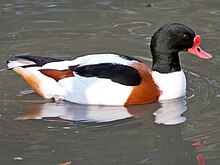Tadorna tadorna
| Common shelduck | |
|---|---|
 |
|
| Breeding male | |
 |
|
| Adult female | |
| Scientific classification | |
| Kingdom: | Animalia |
| Phylum: | Chordata |
| Class: | Aves |
| Order: | Anseriformes |
| Family: | Anatidae |
| Subfamily: | Tadorninae |
| Genus: | Tadorna |
| Species: | T. tadorna |
| Binomial name | |
|
Tadorna tadorna (Linnaeus, 1758) |
|
 |
|
| Range of T. tadorna Breeding range Year-round range Wintering range | |
| Synonyms | |
|
See text |
|
See text
The common shelduck (Tadorna tadorna) is a waterfowl species of the shelduck genus, Tadorna. It is widespread and common in Eurasia, mainly breeding in temperate and wintering in subtropical regions; in winter, it can also be found in the Maghreb. Its scientific name comes from the French name Tadorne for this species. It may originally derive from Celtic roots meaning "pied waterfowl", essentially the same as the English "shelduck".
Fossil bones from Dorkovo (Bulgaria) described as Balcanas pliocaenica may actually belong to this species. More likely, they are an extinct species of Tadorna (if not a distinct genus) due to their Early Pliocene age; the present species is not unequivocally attested from the fossil record until some 2–3 million years later (Late Pliocene/).
The common shelduck resembles a small short-necked goose in size and shape. It is a striking bird, with a reddish-pink bill, pink feet, a white body with chestnut patches and a black belly, and a dark green head and neck. The wing coverts are white, the primary remiges black, and the secondaries green (only showing in flight) and chestnut. The underwings are almost entirely white. Sexes are similar, but the female is smaller, with some white facial markings, while the male is particularly crisply coloured in the breeding season, his bill bright red and bearing a prominent knob at the forehead.
Ducklings are white, with black cap, hindneck and wing and back patches. Juveniles are similarly coloured, greyish above and mostly white below, but already have the adult's wing pattern.
The call is a loud honk.
This is a bird which breeds in temperate Eurasia. Most populations migrate to subtropical areas in winter, but this species is largely resident in westernmost Europe, apart from movements to favoured moulting grounds, such as the Wadden Sea on the north German coast.
...
Wikipedia

